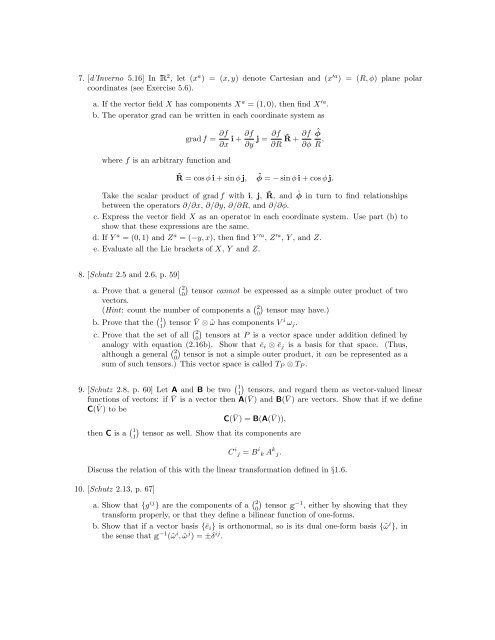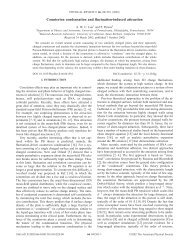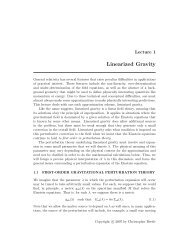Differential Geometry Exercises I: Tensors - Fau.edu
Differential Geometry Exercises I: Tensors - Fau.edu
Differential Geometry Exercises I: Tensors - Fau.edu
Create successful ePaper yourself
Turn your PDF publications into a flip-book with our unique Google optimized e-Paper software.
7. [d’Inverno 5.16] In R 2 , let (x a ) = (x, y) denote Cartesian and (x ′a ) = (R, φ) plane polar<br />
coordinates (see Exercise 5.6).<br />
a. If the vector field X has components X a = (1, 0), then find X ′a .<br />
b. The operator grad can be written in each coordinate system as<br />
where f is an arbitrary function and<br />
grad f = ∂f<br />
∂x i + ∂f<br />
∂y j = ∂f<br />
∂R ˆR + ∂f<br />
∂φ<br />
ˆφ<br />
R ,<br />
ˆR = cos φ i + sin φ j, ˆφ = − sin φ i + cos φ j.<br />
Take the scalar product of grad f with i, j, ˆR, and ˆφ in turn to find relationships<br />
between the operators ∂/∂x, ∂/∂y, ∂/∂R, and ∂/∂φ.<br />
c. Express the vector field X as an operator in each coordinate system. Use part (b) to<br />
show that these expressions are the same.<br />
d. If Y a = (0, 1) and Z a = (−y, x), then find Y ′a , Z ′a , Y , and Z.<br />
e. Evaluate all the Lie brackets of X, Y and Z.<br />
8. [Schutz 2.5 and 2.6, p. 59]<br />
a. Prove that a general ( 2<br />
0)<br />
tensor cannot be expressed as a simple outer product of two<br />
vectors.<br />
(Hint: count the number of components a ( 2<br />
0)<br />
tensor may have.)<br />
b. Prove that the ( 1<br />
1)<br />
tensor ¯V ⊗ ˜ω has components V i ω j .<br />
c. Prove that the set of all ( 2<br />
0)<br />
tensors at P is a vector space under addition defined by<br />
analogy with equation (2.16b). Show that ē i ⊗ ē j is a basis for that space. (Thus,<br />
although a general ( 2<br />
0)<br />
tensor is not a simple outer product, it can be represented as a<br />
sum of such tensors.) This vector space is called T P ⊗ T P .<br />
9. [Schutz 2.8, p. 60] Let A and B be two ( 1<br />
1)<br />
tensors, and regard them as vector-valued linear<br />
functions of vectors: if ¯V is a vector then A( ¯V ) and B( ¯V ) are vectors. Show that if we define<br />
C( ¯V ) to be<br />
C( ¯V ) = B(A( ¯V )),<br />
then C is a ( 1<br />
1)<br />
tensor as well. Show that its components are<br />
C i j = B i k A k j.<br />
Discuss the relation of this with the linear transformation defined in §1.6.<br />
10. [Schutz 2.13, p. 67]<br />
a. Show that {g ij } are the components of a ( 2<br />
0)<br />
tensor g −1 , either by showing that they<br />
transform properly, or that they define a bilinear function of one-forms.<br />
b. Show that if a vector basis {ē i } is orthonormal, so is its dual one-form basis {˜ω i }, in<br />
the sense that g −1 (˜ω i , ˜ω j ) = ±δ ij .






